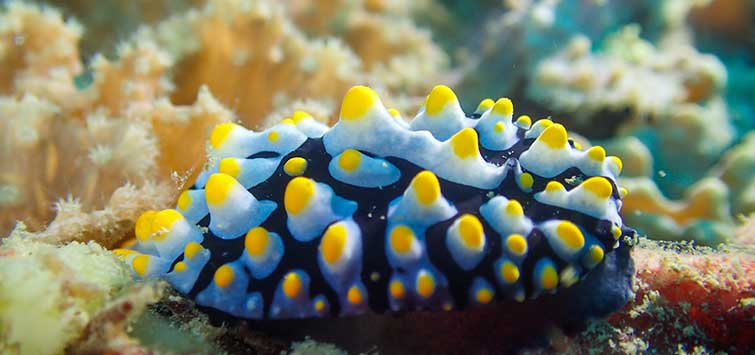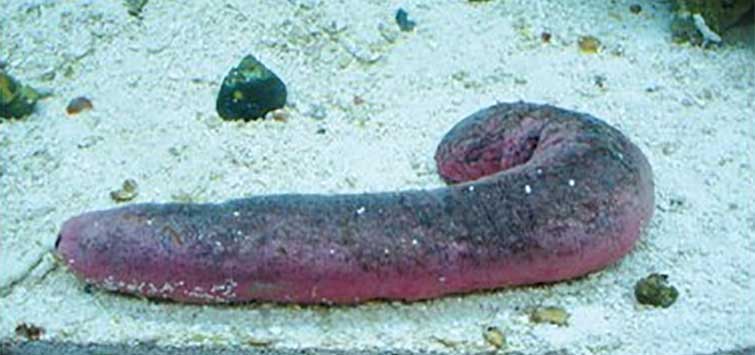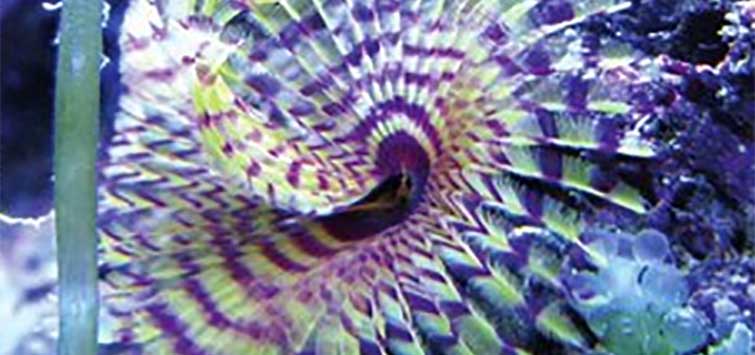Phyllidia varicosa
Common Names: Slug, nudibranch, nudi, nobbed sea slug
Phylum: Mollusca
Class: Gastropoda
Order: Nudibranchia
Family: Phyllidiidae
Range: Widespread in the Indo-West Pacific and Red Sea, and eastward to Hawai‘i
Natural Environment: Generally found in shallow reef environments where various soft corals exist.
Water Requirements: Calcium 380 to 430 mg/l, alkalinity 2.5 meq/l, pH 8.1 to 8.2, specific gravity 1.024 to 1.026, phosphate < 0.015 mg/l, nitrate < 15 mg/l, and a temperature range of 74° to 83°F.
Captive Care
Although often found for sale, this month’s species is an animal that probably no one can actually keep properly. It stands as a warning that almost any nudibranch is unsuitable for the aquarium. While nudibranchs have attracted hobbyists for decades with their exquisite colors, it’s those same colors that send a warning message to their predators—don’t eat me, I taste terrible! These are mostly small, less than 3 inch (8 cm) slugs resembling snails lacking a shell.
Feeding
All nudibranchs are carnivorous. Their lifespan in the wild is approximately one year, depending on species, but it is usually considerably shorter in the aquarium due to their natural food source either being entirely unavailable or in short supply. They are predatory animals that usually feed on a specific food source, such as anemones, gorgonians, hydroids, tunicates, or sponges, and they are such specialized feeders that they may only feed upon one species of a particular group of animals. For example, just knowing a nudibranch eats sponges is not enough, as it will often eat only one or a few species of sponges.
Characteristics
This species is in the only family of sea slugs that likes to roam about during daylight hours. Its body is largely black in color and covered with raised, light-purple/blue horizontal ridges topped with hard yellow or orange bumps, making the animal easy to spot and identify. Though highly attractive, this is a dedicated sponge eater, and unless placed in a system devoted to its needs (one that has the right species of sponge), its life span will be far less than a year—possibly only a few weeks.
Chemicals
This sponge-only feeding requirement is already quite the drawback, but Phyllidia varicosa is also capable of taking chemicals found in the sponges it dines on and transforming them into a toxic substance that protects it from predation by other animals, especially hungry fish. Should this nudibranch be stressed or disturbed, it can secrete a toxic mucus that will kill fish and crustaceans in the aquarium.
Eggs
Some aquarists attracted by this species have reported that when disturbed it will lay an egg ribbon/ring, a series of two to four concentric rings of eggs. Not enough is known about the hatching process, however, and even if breeding was the goal of the aquarist, it should be kept in a species tank with an adequate food supply to continue its existence. It will only eat one or two species of Axinyssa sponges.
Not for Everyone
Unfortunately, this pretty little slug is sometimes sold as a filter feeder, small cucumber, or as a shell-less snail to those unfamiliar with its proper identification and/or needs. In my opinion, this is a species better left in the wild. Though it does show up in the trade due to its beauty, shop owners and hobbyists need to be aware of its requirements (and dangers).

.png?h=595&iar=0&w=2781&hash=5FD5E69473BCC22199FBFA2FB71B6033)



